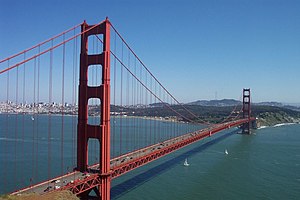 Golden Gate Bridge | ||
| San Francisco | ||
| State | California | |
|---|---|---|
| Residents | 881.549 (2019) | |
| height | 52 feet | |
| no tourist info on Wikidata: | ||
| location | ||
| ||
San Francisco is a busy and cosmopolitan city in California and is situated in a hilly and picturesque landscape. FriscoAs it is often called by tourists but never by locals, it is particularly known for its liberal attitude.
Erected on more than 40 hills, it shines San Francisco, unlike any other city in the world, has a unique and lovable character. With the name "San Francisco" are images of the Cable cars and the two bay bridges Golden gate and San Francisco-Oakland connected. The best travel times are the months of September and October, when there is hardly any fog.
This is a neighborhood with one of the largest and most colorful homosexual communities in the United States. There is also a large Chinese and an Italian quarter. Has a rather sad celebrity The City because of their numerous and historically often catastrophic earthquakes.
Districts

background
The city is on the northern tip of a peninsula that encompasses the San Francisco Bay separates from the Pacific, and has about 750,000 inhabitants. The area is about 125 km².
The city emerged as a Spanish mission station and as a post office for the U.S. Army. In 1848 it experienced a boom due to a gold rush. Today the residents simply call them "The City"
Chronicle of the city
- 1848 - Gold rush and thus large influx to San Francisco.
- 1869 - The Central Pacific Railroad completes the construction of the railway from the east coast to San Francisco. This event is celebrated enthusiastically in the city.
- 1870 - The city government decides that Golden Gate Park to build.
- 1873 - On August 2nd, the cable car, based on the idea of Andrew Hallidies, will make its first trip over the 100-yard route on the Clay Street between the Kearny Street and the Jones Street.
- 1875 - opening of the Pacific Stock Exchange.
- 1876 - The Southern Pacific Railroad completed the construction of the line from San Francisco to los Angeles.
- 1877 - There is serious unrest against the Chinese in July. A citizen safety committee restores law and order.
- 1887 - February 5th goes down in history because it was the only day on which there was snow in all of San Francisco.
- 1903 - Fifteen new banks will be opened within a month. In the following year, the Bank of America, now the largest bank in the world United States.
- 1906 - A major earthquake on April 18th destroyed four fifths of the city. Much worse than the destructive force of the earthquake (8.25 on the Richter scale) is the following, rapidly spreading fire, which the firefighters cannot fight because of the water main line rupture. Around 28,000 houses are destroyed and 500 people lose their lives. During the rapidly advancing reconstruction, many buildings are affected by the Chicago Exhibition from 1893, designed in neoclassical style.
- 1907 - A plague epidemic is successfully brought under control after a few months.
- 1912 - James Rolph becomes mayor and, with 19 years in office, has the longest tenure as mayor of the city. The city's first tram line starts operating in the Geary Street on.
- 1915 - The size Panama-Pacific International Exposition will be in Lincoln Park a few months after the first ship to take the new route over the new Panama Canal took place in San Francisco. Completion of the current town hall.
- 1921 - opening of the M. H. de Young Memorial Museum in the Golden Gate Park.
- 1933 - The island Alcatraz San Francisco becomes a federal penal institution.
- 1934 - A general strike paralyzes San Francisco for weeks.
- 1936 - On November 12th, the San FranciscoOakland Bay bridge opened to traffic.
- 1937 - Opening of the designed by Joseph B. Strauss Golden Gate Bridge.
- 1945 - April 24th: the first UN conference will take place at War Memorial Opera House instead of. Two months later, the United Nations Charter was signed there.
- 1951 - September 18: Japanese Prime Minister Yoshida signs in War Memorial Opera House the treaty that ended hostilities between Japan and the United States regulates.
- 1963 - March 23: The prison on Alcatraz will be closed. A year later, the island is occupied by the Sioux Indians who lay claim to Alcatraz. But they are forced to leave the island in 1971.
- 1967 - April 15: One of the first major anti-Vietnam war peace marches takes place in the Market Street instead of. Others follow at regular intervals.
- 1978 - Mayor George Moscone and Harvey Milk, one of the eleven inspectors, are shot dead in town hall by an ex-colleague who was sacked by Milk. The seven-year prison sentence sparked protest demonstrations. A week later, Dianne Feinstein, Chief Executive Officer of the Inspectors, was appointed Moscone's successor. With her, a woman is moving into the town hall as mayor for the first time.
- 1983 - Dianne Feinstein is re-elected as mayor with an overwhelming majority.
- 1984 - After a two-year closure, the Cable cars put back into operation on June 21st.
- 1986 - Nobel Peace Prize Laureate Mother Teresa sets up a monastery in San Francisco. On the seventh attempt, voters agree to a building restriction on downtown San Francisco. In the future, no more than 4.4 hectares of buildings can be built annually.
- 1987 - While the cityscape was changed by a few new skyscrapers in the early 1980s, there are now more than half a dozen new hotels that have changed the look of the district around the Union Square change. About 16% of the existing office space is vacant. The rents are falling for the first time.
- 1988 - After ten years as mayor, Dianne Feinstein is replaced by Art Agnos. During the excavation work to create the foundation walls for a new bank building on the corner Kearny and Sacramento Street artifacts are discovered showing that the Chinese settled San Francisco before 1850.
- 1989 - For economic reasons, the Pentagon decides to close the Presidio. The citizens protest. On October 17th at 5:04 p.m. (during rush hour), San Francisco was hit by the worst earthquake since 1906 (6.9 points on the Richter scale). The Marinaviertel is hardest hit. A lot of houses fall victim to the fire that ignites due to gas escaping from broken gas pipes. A 2 km section of the San Francisco Bay Bridge-Oakland collapses and buries numerous cars.
- 1990 - June: Large fires, some deliberately started, cause widespread devastation in Southern California.
- 1991 - Two new museums, that Friends of Photography (Ansel Adams Center) and the Museum of the City of San Francisco to open.
- 1995 - Beginning of the dot-com boom. The SoMa district, which was previously a largely run-down industrial area, is being developed and taking on construction projects that are not allowed to arise in the Financial District due to restrictive building regulations.
- 2000 - March: The dot-com bubble bursts. Many startups go bankrupt. The market is recovering, however, and the explosion in house prices in San Francisco is unstoppable.
getting there

By plane
- The 1 San Francisco International Airport(IATA: SFO) is about 15 miles south of San Francisco and is the largest airport in the region. The airport has three national and one international terminal and is served by national and international destinations. International connections include Canada, Asia, Europe and Latin America. The airport can be reached either with the numerous shuttles that go directly to the hotels in the city or with the BEARD. Phone: 650-821-8211.
- The Oakland International Airport(IATA: OAK) is about 20 miles away on the other side of the bay. (Phone: 888-435-9625)
- The San Jose Airport(IATA: SJC) located approximately 75 km (50 miles) south of San Francisco.
Transportation from SFO to Downtown San Francisco

Public transport with fixed stops
The BEARD offers currently the easiest and fastest transport option, at least for those travelers who do not mind moving their luggage by hand. Here are the most important things you need to know for the trip from the airport to San Francisco:
- The individual lines of this S-Bahn system are assigned colors. The bus stop San Francisco International Airport the "Yellow" line is 350 meters west of the airport terminal.
- If you don't want to cover the distance between the terminal and the BART station on foot, you can AirTrain use a service lane that does its laps around the site. The BART station is located at the AirTrain stop "International Garage G", 1 flight down. The use of the little train is free.
- After arriving at the BART station, you buy the required BART tickets from the machine, one for each passenger. These have magnetic strips and can be topped up with any amount. The required amount can be seen from a list attached to the machine. Payment can be made in cash or by credit card. Standard tickets (BART Blue Tickets) cost between $ 9.60 and $ 10.15 for a single journey, depending on how far you want to drive into San Francisco (as of January 2020). The validation is then carried out automatically at the barrier that separates the platforms from the general area. The ticket has to be kept until one leaves the BART system, and at the exit, if one has calculated correctly and the credit has been used up, it is swallowed by the barrier and kept.
- The trams run every 15 minutes. When getting on, be careful not to drive in the northbound direction San Francisco / Antioch and not inadvertently in the opposite southbound direction (Milbrae, line "Purple"). The journey takes between 18 and 32 minutes, depending on how far you drive into San Francisco.
- If you plan to use the BART more often, you can save some money by getting one right from the start Clipper Card concerned.
If you are not in a hurry or want to drive the entire route above ground, you can also get one bus to use. If you only have a small piece of luggage, take it San Mateo County Transit (SamTrans) bus KX express ($ 5, 2015). It departs from the lower level every half an hour and reaches the city in about 40 minutes. bus 292 grants more luggage, but requires one hour (every 30 minutes, 5:30 a.m. to 1:00 a.m., $ 2 (day ticket $ 5), children up to 17: $ 1.50 (day ticket $ 3), 2015 ). [www.samtrans.com]
Means of transport that take customers directly to the hotel
- Shuttle: Shuttle operators are SuperShuttle (415-558-8500; 800-258-3826), San Francisco City Shuttle (888-850-7878), American Airporter (415-202-0733 or 800-282-7758) and Bay shuttle (415-564-3400).
- taxi: You only take a taxi if you are more than one person or if money is not an issue. The trip to the city center costs approximately $ 40 (plus tip) and takes approximately 30 minutes. You should look for taxis on the lower level outside the baggage claim area. Current fare estimates are posted on the yellow columns in all boarding areas. Taxi starters are on duty between 8 a.m. and 1 a.m. to support passengers with questions or problems.
- Over: Is much more common in the USA than in Germany and can save money compared to regular taxis.
Transportation from OAK to Downtown San Francisco
- Express transport: The AirBART-Shuttle bus takes you to the Coliseum BART (Bay Area Rapid Transit) station. It departs from Terminal 1 every 15 to 20 minutes from 4:00 a.m. to midnight. On Sundays it runs from 8:00 a.m. to midnight.
- Shuttle: Try Airport Connection (415-282-7433), Airport Express (800-327-2024) or RBJ Airporter (510-562-3434).
- taxi: There are taxi ranks on the junction between Terminals 1 and 2. It takes between 30 and 40 minutes to get to downtown San Francisco (longer during peak hours) and costs between $ 45 and $ 50.
By train
Caltrain operates a railway line that runs from rural Gilroy above San Jose arrives in San Francisco. The main train station is called San Francisco 4th Street / King Street. Two other San Francisco train stations are located in the southeast of the city. Caltrain enables an hourly connection between San Jose and San Francisco, which is a high frequency of trains by American standards. The two largest airports in the metropolitan area of San Francisco are also located on the train route.
Amtrak primarily serves the suburb of Emeryville, from where a bus (provided by Amtrak) can cover the rest of the way to San Francisco. A new train station in San Francisco as well as a new (faster) railway line from San Francisco to Los Angeles are currently under construction.
By bus
In the street
By boat
San Francisco has 2 cruise terminals:
- that opened in 2014 2 Pier 27 terminal
- the older terminal 3 Pier 35 near Fisherman's Wharf.
In exceptional cases 4 Pier 30 next to the Bay Bridge used.
mobility

San Francisco is one of the big cities in the USA where you can get almost everywhere without a car, as SF has a very good network of public transport. The two big operators, BART and MUNI, have separate tariffs, even for season tickets. A one-way trip with a cable car costs $ 5 you can move very well at least in downtown San Francisco - the distance from the Tenderloin / Civic Center to the piers can be covered in 20 minutes for experienced pedestrians.
In the street
You don't need a car in San Francisco unless you want to see other parts of the Bay Area. Finding street parking in the city center can be unbearable and illegally parked cars are almost always fined and sometimes towed. As always in major American cities, a look at the Parkopedia help. Parking garages are often full, however, and you also have to consider the horrendous parking fees that are incurred in the most visited areas. That adds up to ten dollars an hour. Most of the time you can find free parking spaces just a few minutes' walk away. Parking spaces in the 'South of Market' area are usually cheaper. When parking the car down into a parking space, turn the wheels towards the sidewalk. When parking upwards, the wheels must be turned away from the curb. If this is not observed, you will be warned. The colors of the curb are also important. Unless otherwise stated, you can park in front of the colorless or gray-painted curbs. Green curbs only allow ten minutes of parking. White curbs only allow you to stop for a short time. Only disabled people are allowed to park near blue curbs. Avoid the red and yellow curbs. Driving under the influence of alcohol is strictly sanctioned.
taxi

Taxi service is generally quick and courteous, although the fees ($ 2.85 base fee, $ 2.25 per additional mile, plus $ 0.45 per minute) are high and it is often difficult to hail a cab on the street. Big hotels have taxi ranks. You can also order a taxi by phone. The main companies are: Yellow (415-626-2345), Veteran's (415-552-1300), Luxor (415-282-4141) and Pacific (415-986-7220).
Public transportation
- San Francisco Municipal Railway (MUNI), Operators of underground trains, buses and trolley buses, trams (underground in the city center and above ground in the neighborhoods), the historic tram line F and cable cars. The MUNI has been in operation since 1912, making it the oldest functioning tram system in the country. The MUNI transports an average of 700,000 people a day. Some lines are served 24 hours. A single trip for bus and tram costs $ 3 for the driver (as of 01/2020). The exact amount is required or there is no change. For MUNI, a day pass is $ 21, a three-day pass is $ 32, and a seven-day pass is $ 42. These are valid on all bus, tram and cable car lines and offer discounts on some entrance fees. These passes are not sold at vending machines, but only at authorized points of sale (a little difficult to find) and at the Powell cable car terminus. 949 Presidio Avenue, Room 238, San Francisco, CA 94115-3399, Line plan

- One mode of transport that is only available in San Francisco today is that Cable cars. A cable car is not an ordinary tram that has its own drive machine, but a passive cable tram. The cables run in a guide in the street, are constantly in motion, and when the cable car is supposed to travel, it is clamped to the cable; it is disconnected again to stop. The process was patented in 1869 and was temporarily used all over the world. Because conventional trams could not run on the hills of San Francisco, 23 cable car lines were built here between 1873 and 1890, three of which have been preserved for sentimental reasons. All three lines are located downtown and are now used almost exclusively by tourists. For more information about this extraordinary mode of transport see the article about Downtown.
- The Bay Area Rapid Transit or abbreviated BEARD is a kind of S-Bahn, which the Bay Area served by 81 miles of tracks, approximately 19 miles of which are underground. It connects San Francisco with communities south and the airport as well as the east side of the bay. There are connections such. B. after Berkeley, Oakland as well as to the airports of San Francisco and Oakland. There are 37 stations. The A line of Fremont to Lake Merritt is 23.4 miles long, the M line of Colma to Oakland West is 16.6 miles, the R line from Richmond to MacArthur is 10.3 miles; the C line of Bay Point to Rockridge is 25.3 miles and the RK line from Rockridge to Oakland West is 5.2 miles. Downtown stops are along Market Street at the Civic Center, Powell Street, Montgomery Street and the Embarcadero. Trains run from 4:00 a.m. to midnight on weekdays and run every three to four minutes during rush hour. Trains run from 6:00 a.m. to midnight on Saturdays and from 8:00 a.m. to midnight on Sundays. Approximately 250,000 passengers use the BART every week. The prices vary depending on the distance from $ 1.75 to $ 10.55 per trip (e.g. San Francisco Downtown - Airport $ 8.25, travel time about 30 minutes, 2014). You can buy tickets from machines in every station. There are magnetic strips on the tickets that are used to debit the costs for each trip. The top-up amount is freely selectable, so that you can also buy exactly for a specific trip. Bay Area Rapid Transit (BART)
- Caltrain, 1250 San Carlos Ave. San Carlos, CA 94070-1306, Phone: 800.660.4287 Caltrain connects San Francisco with the Silicon Valley and the San José International Airport
- Ferries - Some passenger ferries cross San Francisco Bay from various destinations in Marin County, East Bay, and North Bay. For more information please contact: Golden Gate Ferries (415-455-2000 or 511-toll-free), Red & White Fleet (415-673-2900 or 800-229-2784), Blue and Gold Fleet (415-705-5555) and Harbor Bay Maritime (510-769-5500).
- San Francisco Bay Ferries
.jpg/120px-EM_DSC_5220_(3207652197).jpg)
The Royal Princess of the Red & White Fleet

The Marin from Golden Gate Ferry
By bicycle
In addition to the usual bike rental options, there is also in San Francisco Bay Area Bike Share a rental system with fixed locations that can be used by everyone (similar to the Call-a-Bike system in Germany). Here you need a credit card with which you can make the booking at the machine, you pay 9 USD for 24 hours or 22 USD for 72 hours and can then use a bike anywhere for a maximum of 30 minutes and at everyone during this time Return the station. Surcharges are added for longer use in one piece. Long-term rentals (i.e. for bike tours outside the station area) are therefore unattractively expensive. The next bike can be borrowed from 2 minutes after a successful return. Attention: A security deposit of USD 101 per bike will be blocked on the credit card when using it! The station density is medium and the area served includes the area near the Oakland Bay Bridge. A road map with cycle paths and all stations is available at every station, so that you can plan longer tours through the city, including changing your bike.
A maximum of two bicycles can be borrowed with one credit card. Groups should therefore have several credit cards with them.
Attention: when you return the bike to the station, make sure that the bike locks into place correctly (first yellow, then green light and confirmation tone), otherwise the bike is considered not to be returned and it can be really expensive. Sometimes it helps to raise the rear of the bike.
Tourist Attractions
Landmark
- 1 Golden Gate Bridge. The Golden Gate Bridge has a total length of 2,737 meters and spans the water of San Francisco Bay at a height of 227 meters. The east side offers a fabulous view of downtown San Francisco, from the west side you can see the Marin Headlands and the Pacific. Walking the bridge does not cost anything. Parking and access are available in the district Presidio.
- The most distinctive skyscraper in the city is the Transamerica pyramid in the Financial District. The 260 meter high needle was built in 1969-1972 and mainly contains office space.
- 1 Fisherman’s Wharf (Downtown) has everything that tourists like, and it just so happens that there are some really good photo opportunities and museums.
- The prison island, discarded in 1963 Alcatraz is now a museum and can be visited with excursion boats (see Downtown). Very few visitors know that 14 km to the northeast is the maximum security prison San Quentin, where people are still executed today. Attending a vigil at the gates of San Quentin is certainly a more intense experience than gawking on Alcatraz. Information is available in the local media.
- The 2 Lombard Street Curves in the Russian Hill district (Downtown) and the 3 Painted ladies at Alamo Square (Western addition) are other popular photo opportunities.
Golden Gate Bridge (a bit of fog is almost always)
Transamerica pyramid
.jpg/271px-Fisherman's_Wharf_(9420511365).jpg)
Fisherman’s Wharf
.jpg/120px-Alcatraz_(14693798129).jpg)
Alcatraz
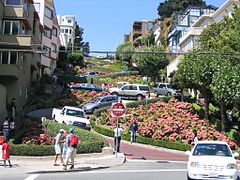
Lombard Street Curves

Painted ladies
Districts with character
- One of the top attractions in San Francisco that were not specially made for tourists is the Chinatown in Downtown. The Chinese immigrants, who came by the thousands after civil wars and famine, founded this settlement in 1848. Chinatown was completely destroyed by the earthquake of 1906, but then rebuilt, and it is still a center of Chinese life in San Francisco today.
- The district Mission District has been populated mainly by Latinos since the middle of the 20th century. The LGBTQ community has been pushing ahead since the 1970s; however, the Latin American influence is still very present.
- The Castro has been the gay district of San Francisco since 1967. Bars, clubs, restaurants, boutiques, bookstores and lots of rainbow-colored street life.
- The district North Beach in Downtown has become a after the earthquake of 1906 Little Italy developed. Other influences came later, but North Beach still has a high density of Italian restaurants and cafes.
- Haight-Ashbury has been the world capital of hippie culture since the 1960s. The world's first head shop opened on Haight Street in 1966, and Janis Joplin and the members of Jefferson Airplane and the Grateful Dead lived here. In the meantime other residents have moved up, traces of the Summer of Love (1967) can still be found, for example at Amoeba Music, according to its own information, the largest independent music store in the world.
- In the Western addition is only 6 blocks in size Japantown. Not quite comparable to Chinatown, but still a must-visit for lovers of Japanese cuisine.
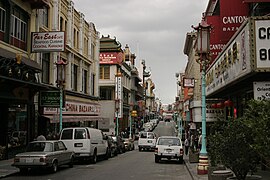
Chinatown
The Castro

Little Italy
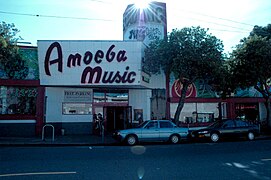
Amoeba Music (Haight-Ashbury)
Japantown
- The Financial District is the traditional financial district of San Francisco. Six Fortune 500 companies have their headquarters here today. Sights include the Transamerica Pyramid and some other interesting skyscrapers that were built here before strict building codes stopped the neighborhood's height growth in the late 1980s.
- Around the Union Square Those interested in fashion will find posh department stores, boutiques and jewelers. Architecture fans will also find some sights here, such as the Hallidie Building or the Rotunda on the top floor of the Neiman Marcus department store.
For the prospect
- On Telegraph Hill in Downtown lies the Coit Tower, a 64-meter-high observation tower, a destination for many city hikers.
- The Twin peaks are a 276 or 277 meter high double hill in the Downtown san francisco, which can be conveniently accessed by car. Well-trained people can also climb it on foot or by bike. The view is overwhelming and goes in all directions.
- Mount Davidson in the Southwest of San Francisco is less famous than Twin Peaks, but a little higher at 283 meters. A hiking trail leads up to the summit.
- It is hardly visited by tourists either Grand View Park. The 203 meter high hill that leads to the Golden Gate Heights has a 360-degree view of Golden Gate Park, Twin Peaks, and Sunset.
- For the most famous cityscape one has to leave San Francisco and cross the Golden Gate Bridge to the Marin Headlands drive. The Hendrik Point can be reached via Conzelman Rd and has the geo-coordinates 37.827636, -122.481666.
- The best vantage point in the Golden Gate Park is 44 meters high Hamon Tower of the De Young Museum. Unlike the museum, the tower offers free entry, and then a 360-degree view of the park.
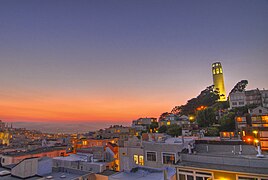
Coit Tower
View from Twin Peaks of Downtown (a zoom helped a bit)

View from Mount Davidson

Grand View Park

Golden Gate Bridge and San Francisco as seen from Hendrik Point
Hamon Tower (De Young Museum)
Churches and Religious Sites
- The little church of the San Francisco de Asís Mission, better known as Mission Dolores, is the oldest building in the city. She lies in Mission District.
- A must-do for jazz fans is attending a church service in the small one Saint John Coltrane African Orthodox Church in the district Western addition.
- in the Tenderloin lies the Glide Memorial Church, a Methodist church opened in 1930 that has the most breathtaking gospel choir in town.
- The Saints Peter and Paul Church in North Beach offers the most beautiful confectionery architecture. Marilyn Monroe married the baseball idol Joe DiMaggio here.
- The is considered the most remarkable Buddhist temple in San Francisco Hua Zang Si Temple in the Mission District. He is housed in a former church.
- The Catholic Church St. Dominic in the Lower Pacific Heights district (Western addition) is little known by travelers, but one of the most beautiful in town.
- Grace Cathedral in the district Nob Hill is another wonderful neo-Gothic church building.
Mission Dolores
Coltrane Church

Glide Memorial Church

St. Peter and Paul Church
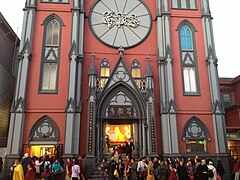
Hua Zang Si Temple
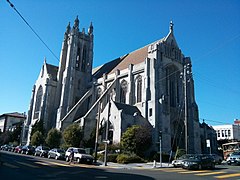
St. Dominic
Grace Cathedral
Other structures
- The Palace of Fine Arts is a building complex that was built for the 1915 World's Fair. The adjacent exhibition hall housed the Exploratorium until 2013; Today it is used for different purposes, including a theater.
- The one built in 1907 Columbus Tower (Sentinel Building) in the district North Beach Today houses the film production company of Francis Ford Coppola and George Lucas.
- In the district SoMa, at the corner of Mission St & 1st St, is currently the tallest building in the city with 326 meters, the Salesforce Tower.
- The only Victorian residence currently open to visit as a museum is this Haas-Lilienthal House in the Pacific Heights.
- One of the most notable new buildings in the city is the im Golden Gate Park located and completed in 2008 California Academy of Sciencewhich houses a large natural history museum.
- The for Civic Center proper City Hall, San Francisco City Hall, was built from 1913 to 1915 in the Beaux Arts style. 2004 wurden hier auf Anordnung des damaligen Bürgermeisters Gavin Newsom erstmals in der Geschichte des Landes Trauungen gleichgeschlechtlicher Paare durchgeführt.
- Das 2005 fertiggestellte Curran House in the Tenderloin bildet ein Beispiel für progressiven sozialen Wohnungsbau.
- At the Union Square findet man den V. C. Morris Gift Shop, das einzige Bauwerk, die Kult-Architekt Frank Lloyd Wright in San Francisco hinterlassen hat (siehe auch: Kalifornien/Frank Lloyd Wright). Das 1948 designte Gebäude hat einen spiraligen Ausstellungsraum, wie Wright ihn 11 Jahre später auch für das New Yorker Guggenheim-Museum verwendet hat.

Palace of Fine Arts
Columbus Tower (im Hintergrund die Transamerica Pyramid)
.jpg/240px-Salesforce_Tower_(34578890725).jpg)
Bauarbeiten am Salesforce Tower (Mai 2017)
Haas Lilienthal House
California Academy of Science

City Hall

Curran House

V.C. Morris Store
Museums
In San Francisco gibt es mehr als 50 Museen, die die unterschiedlichsten Themengebiete und Geschmäcker abdecken. Für Einzelheiten siehe: San Francisco/Museen. Hier einige der namhaftesten:
- Exploratorium, The Embarcadero & Green St, Downtown. Ein Must-See für Familien mit Kindern im Vor- und Grundschulalter ist das zur Pier 15 umgezogene Exploratorium. Die permanenten Ausstellungen umfassen etliche Hunderte von interaktiven und zum Teil extrem kreativen Exponaten zu naturwissenschaftlichen und technischen Themen. Das Museum gilt als das beste seiner Art weltweit.
- California Academy of Sciences, 55 Music Concourse Dr. Die im Golden Gate Park gelegene California Academy of Sciences ist eines der größten naturkundlichen Museen der Welt und umfasst u.a. Ausstellungen zur Naturgeschichte (Kimball Natural History Museum), das Morrison Planetarium, einen künstlichen tropischen Regenwald und das sehr große Steinhart Aquarium.
- Walt Disney Family Museum, WDFM; 104 Montgomery St. Als eines der unterhaltsamsten Museen der Stadt gilt das erst 2009 eröffnete Walt Disney Family Museum, das über Leben und Werk des Filmproduzenten und Pioniers der amerikanischen Unterhaltungsindustrie informiert. Das Museum ist auf dem neu gestalteten Gelände des Presidio untergebracht.
- Legion of Honor Museum, 100 34th Ave, Lincoln Park. Das populärste Kunstmuseum in San Francisco ist das sehr großzügig angelegte Legion of Honor Museum. Zu sehen ist antike und europäische Kunst, darunter Werke von El Greco, Rubens, Rembrandt, Rodin, Braque und Picasso, sowie viele Werke des französischen Impressionismus.
- Cable Car Museum, 1201 Mason St, Nob Hill. Das kleine Cable Car Museum lockt San-Francisco-Besucher mit freiem Eintritt und erklärt, warum dieses Verkehrsmittel weltweit einzigartig ist.
- Asian Art Museum, 200 Larkin St, Civic Center. San Francisco ist die am stärksten chinesisch geprägte aller nordamerikanischen Städte. Schon allein darum verdient das Asian Art Museum einen Besuch.
- Musée Mécanique, Fisherman’s Wharf = Pier 41. Das kleine Musée Mécanique sieht auf den ersten Blick wie eine Touristenfalle aus. Tatsächlich verbirgt sich dahinter aber eine der weltweit größten Sammlungen historischer Spielmaschinen und Automaten.
- San Francisco Museum of Modern Art, SFMOMA; 151 3rd St, SoMa. Das San Francisco Museum of Modern Art ist eines der bedeutendsten Museen weltweit für amerikanische und europäische Kunst des 20. Jahrhunderts.

Exploratorium
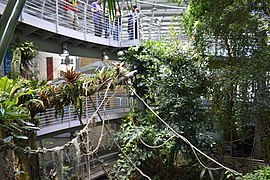
California Academy of Sciences

Legion of Honor

Cable Car Museum
Musée Mécanique
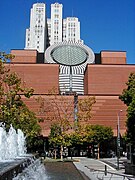
SFMOMA
Parks, Gärten und Strände
- Der größte Park der Stadt – der Golden Gate Park im Stadtteil The Avenues – bietet mehrere erstklassige Museen, einen botanischen Garten mit Arboretum, ein historisches Gewächshaus, einen pittoresken japanischen Teegarten und vieles mehr. Viele nahe gelegene Geschäfte vermieten Inline-Skates.
- The San Francisco Zoo liegt etwas abseits im Südwesten der Stadt. Zu seinen Besonderheiten zählt seit 1979 ein großer Insektenzoo.
- Die Einheimischen halten Marshall’s Beach für den schönsten Strand der Stadt. Der Strand liegt am Rande des Presidio, erlaubt – in den USA ist dies eine Rarität – FKK und bietet Aussicht auf die Golden Gate Bridge. Zum Baden ist das Wasser leider zu kalt.
- Wenn man Einheimische fragt, welcher Park der schönste in San Francisco sei, erhält man gelegentlich zur Antwort: Fort Funston. Dieser bei Touristen völlig unbekannte Park liegt im Südwesten der Stadt, zwischen Lake Merced und Pazifikstrand. Wundervolle Sonnenuntergänge.
- Also the Sutro Heights Park liegt etwas abseits am Rande der „Avenues". Ganz in der Nähe befinden sich das Cliff House und die Ruinen des Sutro Baths.

Conservatory of Flowers (Golden Gate Park)
Japanese Tea Garden (Golden Gate Park)

Madagaskar-Fauchschaben im San Francisco Zoo
Marshall’s Beach

Fort Funston

Blick vom Sutro Heights Park auf Ocean Beach
activities
in the Civic Center zwischen Japantown und SoMa findest Du das Performing Arts Center bestehend aus der Davies Symphony Hall, War Memorial Opera House (in dem 1945 der Vertrag zur Gründung der Vereinten Nationen unterzeichnet wurde), Veterans Building/ Herbst Theatre, City Hall and the Main Library.
- Diverse Fahrradverleihe bieten einem für rund 20 USD/Tag einen Drahtesel an, mit dem man zum Beispiel einen Abstecher über die Golden Gate Bridge in den ungleich wärmeren Marin County machen kann. Genügend Ausdauer, Kondition und das richtige Fahrrad vorausgesetzt, kann man auch die Bucht halb umqueren oder einen der Berge erklimmen und die Aussicht genießen. Lediglich einen Trip zum Burning Man Festival sollte man nicht mit dem Rad machen - die Verleiher weisen ausdrücklich darauf hin, dass die Fahrräder vom Wüstenstaub irreparabel verschmutzt werden. Zum Teil bieten die Verleiher Gästen der Jugendherbergen Sonderkonditionen - einfach im Hostel fragen.
- Feste und Events
- Folsom Street Fair. Immer am letzten Sonntag im September findet in der Folsom Street etwa zwischen der 7th und 9th Street ein buntes Treffen von Freunden der unterschiedlichsten Fetische statt. Bei meist schönem Wetter in dieser Jahreszeit kommen etwa 300.000 Besucher aller sexuellen Präferenzen zusammen und tragen zur Schau, was sonst auf der Straße nicht tragbar ist. Als Eintritt wird eine Donation von 5 US$ erwartet, Veranstaltungszeit ca. 11.00 – 18.00 Uhr.
- Christopher Street Day Parade
- Chinese New Year
- Halloween
- 1 Moscone Center (Moscone Convention Center), 747 Howard St, San Francisco, CA 94103. Tel.: 1 415-974-4000. Ein im Stadtzentrum gelegenes Messegelände, das 700.000 Quadratfuß an Ausstellungräumen, 106 Konferenzzimmern und beinahe 123.000 Quadratfuß Vorhalle enthält.
- 2 Lincoln Park Golf Course, 34th Ave und Clement St, San Francisco, CA 94121. Tel.: 1 415-750-4653. Auf den Klippen über dem pazifischen Ozean gelegen hat dieser Golfplatz eine Aussicht auf die Golden Gate Bridge an vielen seiner 18 Löcher. Dieser kurze, hügelige, baumgesäumte und straffe Kurs wird die Stadt von San Francisco betrieben und ist Austragungsort der Stadtgolfmeisterschaften.
- 1 Aussichtspunkt an der Conzelman Road
Touren, Rundfahrten, Führungen
The San Francisco City Guides sind ehrenamtliche Stadtführer, die im Auftrag der SF Public Library dutzende Stadtführungen zu den verschiedensten Themen anbieten - vom Erdbeben von 1906 über den Goldrausch bis zur Führung durch das Civic Center. Die Qualität der Führung variiert je nach dem Leiter der Stadtführung, zeichen sich aber durch eine persönliche Note aus und sind im Durchschnitt sehr empfehlenswert. Die Führungen sind an sich kostenlos, es werden am Ende Spenden gesammelt (üblich sind 5-10 USD)
shop
Fans unabhängig produzierter Rockmusik, besonders solcher der Hippie-Zeit, besuchen am besten den Stadtteil Haight-Ashbury. Freunde exklusiver Modemarken besuchen den Stadtteil Union Square. Eine große Zahl von Spezialitätenläden findet man auch im Ferry Building am Rande des Financial District
- 1 Westfield San Francisco Centre (San Francisco Shopping Centre), 865 Market St, San Francisco, CA 94103. Tel.: 415-495-5656. Ein im Oktober 1988 eröffnetes Einkaufszentrum, mit sechs Spiralrolltreppen und mehr als 100 Geschäften und Gaststätten, die in einer Marmor-, Granit- und Glasstruktur mit einem 150 Fuß hohen Atrium untergebracht sind. Das Einkaufszentrum liegt an der Fifth St.Geöffnet: Öffnungszeiten: Mo – Sa 9.30 – 20.00 Uhr, So 11.00 – 18.00 Uhr.
- Nordstrom. Exklusives, mondänes Kaufhaus mit Live-Klaviermusikuntermalung.
kitchen
- 2 Boudin SF, 160 Jefferson Street, Lower Level, San Francisco, CA 94133 (Fisherman's Wharf). Tel.: 1 415 928 1849.Die Boudin Bakery wurde 1849 von dem Franzosen Isidore Boudin gegründet, sie ist berühmt für ihr Sauerteigbrot. Im Stammhaus (es gibt weitere Filialen in der Stadt) an der an der Fisherman’s Wharf kann man bei der Zubereitung des Brotes zusehen, das Bakery Museum besuchen, Sauerteog-Produkte einkaufen, oder einfach nur das Brot geniesen. Es gibt Sandwiches, Baguettebeefburger, oder Suppen, Eintöpfe, Chillies oder Muschelsuppe (Clam Chowder in a Sourdough Bowl) im ausgehölten Sauerteigbrot.Geöffnet: täglich 8:00 - 21:00 Uhr.Preis: Sandwich oder Suppe 10 $.

Bei Boudin gibt es ungewöhnliche Brotformen
Clam chowder im ausgehölten Sauerteigbrot
Frühstück
Café, Bistro
- Café NOOK, 1500 Hyde Street Ecke Jackson. Das im Stadtteil Russian Hill gelegene kleine Café ist ein echter Tipp. Zum Programm gehört auch organische und vegane Kost. Sehr empfehlenswert die organische Limonade. Kostenloses WLAN.
restaurant
- Blowfish Sushi, 2170 Bryant Street. Das legendäre Blowfish Sushi für Sushikenner, in der gehobenen Preisklasse.
- La Mar Cebicheria Peruana, Embarcadero Pier 1-1/2. Spezialist für peruanische Rohfischgerichte, Tiraditos, aber auch Steaks, Pasta, Risotto usw., raffiniert zubereitet, und eine Bar mit großer Palette an Cocktails. Aussicht auf die Bay.Preis: Mittlere bis gehobene Preisklasse.
- Benu, 22 Hawthorne St (SoMa). Dieses Upscale-Restaurant und sein Chefkoch Corey Lee sind 2017 mit dem James Beard Foundation Restaurant and Chef Award ausgezeichnet worden.
nightlife
San Francisco, durch den späteren, großen Feuilletonist Kraut Caen als Bagdad der Bucht betitelt, bietet eine viefältiges Nachtleben von elegant bis zu extrem eklektisch an. Ob Dein Herz auf eine Nacht in der Oper, am Ballett oder an der Symphonie eingestellt wird (konsultiere das lokale Programm für das War Memorial Opera House oder Louise M. Davies Symphony Hall) eingestellt ist oder ob Du lieber bis zur Dämmerung in einer der vielen Clubs im South of Market tanzen möchtest, Du findest Deine Nische in San Francisco.
In einer Stadt, die für ihre atemberaubenden Aussichten berühmt ist, ist es nicht verwunderlich, dass einige der populärsten (und kostspieligsten) Kneipen Räume mit Panoramaausichten sind. Mit einem Platz auf der höchsten Ebene des Mark Hopkins Hotel, welches 1996 renoviert wurde und jetzt wieder mit der gleichen Pracht wie vor dem Zweiten Weltkrieg erscheint, dem Top of the Mark, kannst Du allabendlich Unterhaltung mit einer spektakulären Aussicht durch Fenster, welche vom Fußboden bis zur Decke reichen, genießen. Für die erhabensten Bar-Aussichten steige zum Carnelian Room auf dem 52 Stockwerke hohen Bank of America Building, welches das höchste in San Franciscos ist. Männliche Gäste haben in Anzügen zu erscheinen. Abendessen zum Festpreis werden in der Gaststätte angeboten, die sich auch der größten Weinliste in der Bay Area rühmt (über 1200 Weine).
Der Tonga Room im Fairmont Hotel hat wenig Aussichten (es gibt keine Fenster), hat dafür aber viel Kitschatmosphäre. In dieser berühmten Tiki-Lounge, die für ihre kostspieligen Rummischungen berühmt ist, kannst Du an einem Lagunentisch sitzen um die Band zu genießen, die innen auf einem Floß schwimmt. Periodische Regenstürme fügen etwas tropische Ambiance hinzu.
Geschäftemacher können ihre Kapitalgewinne im eleganten Art-Deco Redwood Room des Clift Hotels rösten. Sitze auf polierten mit Rotholz verkleidetenen, aus dem Jahre 1933 stammenden Stühlen und nippe an einem der berühmten Martinis des Redwood Rooms, während Du das Repertoire des Pianisten aus den Dreißiger und Vierziger Jahrgängen genießt.
Eine seit mehr als 20 Jahren feste Adresse in North Beach ist des Beach Blanket Babylon, welches im Club Fugazi inszeniert wird. Dies ist die am längsten laufende musikalische Revue in der Geschichte. Das Aufführungen ändern regelmäßig, Parodien werden hinzugefügt. Eine Besonderheit sind die größten und durchdachtesten Hüte des Theaters und möglicherweise der Welt.
Überprüfe den Bimbo's 365 Club an der Ecke von North Beach für eine elegante fünfziger Jahre Nachtklub-Atmosphäre und Hip Musikaufführungen. Der Club wurde 1935 eröffnet und befindet sich seit 1951 an der jetzigen Adresse. Bimbo's zeigt nicht mehr die hochtretenden Revuetänzerinnen, aber Du kannst ruhig Dolfina, das zierliche Mädchen im Aquarium sehen, welches in einem Aquarium hinter dem Bar schwimmt. (Tipp: es wird mit Spiegeln gemacht)
Abseits im Cannery Complex, nahe der Fisherman's Wharf ist der Cobb's Comedy Club der beste Ort um Komiker in einer Stadt die berühmt für ihre Komiker ist, zu sehen. Das einstige Speakeasy Café Du Nord gilt als einer der besten Jazz-Clubs der Stadt. Es liegt an der oberen Market Street und bietet spezielle Lounge-Musikprogramme und Salsa- oder Swing-Nächte (inklusive Tanzstunden) sowie auch einige der besten Jazzinterpreten rundherum. Nimm ein Taxi und gehe nach South of Market um große Jazz-, Blues-, R&B- und Rockkonzerte im Slim's zu erleben. Dieses ist der beste Ort, um Musik zu hören.
South of Market ist auch eine Brutstätte für trendige Tanzlokale und Clubs, die die ganze Nacht geöffnet sind. Die Szene ändert sich ständig. Konsultiere die Lokalblätter wie der Bay Guardian and SF Weekly für aktuelle Informationen.
- Metreon, 101 4th Street. Das Sony Metreon Entertainment Center ist eine Mischung aus Restaurants, Kneipen, dem Loews Theatres Metreon Multiplexkino und dem Sony Entertainment Center mit den neuesten virtuellen Spielewelten von Sony. Im gesamten Komplex gibt es WLAN kostenlos.
Cheap
- Cat Club, 1190 Folsom Street. Der Cat Club ist donnerstags ein Tip für Partygänger die ausgelasse und feuchtfröhliche Parties in ungezwungener Atmosphäre lieben. Das Publikum ist bunt gemischt, sowohl Einheimische als auch Besucher aller Nationalitäten sind hier willkommen. Wer alleine kommt findet meist schnell nette Bekanntschaften. Die Getränkepreise sind relativ niedrig, die Stimmung dementsprechend ausgelassen. Zwei Räume warten mit Hits aus den 1970er, 1980er Jahren und elektronischer Musik auf.
medium
In San Francisco gibt es zahlreiche "Brewpubs", in denen neben selbst gebrauten Bieren auch Essen geboten wird. Sehr zu empfehlen sind z.B. 21st-amendment in South of Market und Magnolia in The Haight.
Upscale
accommodation
San Francisco ist neben New York City die Stadt in den USA mit den im Durchschnitt teuersten Hotelzimmern. In den Hotels der Best-Western-Kette z.B., die in anderen Landesteilen Zimmer für unter $100 anbietet, bezahlt man in San Francisco mindestens $255. Eine gründliche Recherche vorab kann sicherstellen, dass man für das viele Geld zumindest ein anständiges Quartier bekommt.
Falls man San Francisco als Startpunkt für eine Rundreise wählt, sollte man als erste Unterkunft ein Motel mit kostenlosem Bustransfer vom und zum Flughafen wählen. So spart man sich auch die Mietwagenkosten für einen Tag, da die Flüge aus Europa meist am späten Nachmittag in San Francisco landen. Zudem ist zu beachten, dass das Unterstellen eines Fahrzeugs im Zentrum eine kostspielige Angelegenheit darstellt (ca. 20 - 40 US$ pro Tag). Je nach Lage des Hotels kommt auch eine Fahrt mit der BART in Frage.
Cheap
- Shih Yu-Lang Central, 220 Golden Gate Avenue. Hotel der Young Men Christian Association (YMCA).Preis: Bett im Schlafsaal ab US$ 23.50 (nur im Winter; einschl. Steuer), auch Einzelzimmer mit Bad.
- Travelodge San Francisco Airport North, 326 South Airport Boulevard, South San Francisco. Mit kostenlosem Transfer vom und zum Flughafen.
- Hostelling International. Hostelling International hat drei Jugendherbergen in San Francisco: City Center am Rande des Tenderloin, Downtown unweit vom Union Square und Fisherman's Wharf im Norden der Stadt. Das Hostel im City Center (Ellis Street) liegt schon einige Schritte im eher ruppigen Tenderloin, ist aber über die Straße am Civic Center vorbei problemlos und ohne Zwischenfälle zu erreichen, selbst in der Nacht. Internetterminals vorhanden, regelmäßige organisierte Aktivitäten (Fahrradtouren, Besuch eines Baseball-Spiels in Oakland etc.) und die HI-übliche Atmosphäre.
medium
- Air Travel Hotel. Preis: Einzelzimmer ab US $ 99.00.
- The Mosser Hotel. Preis: Einzelzimmer ab US$ 69.00.
Upscale
Learn
Work
security
San Francisco ist eine sichere Stadt - mit Vorsicht und Umsicht ist jedoch ein Ausflug ins Tenderloin nach Anbruch der Dunkelheit zu genießen.
health
Practical advice
- San Francisco Visitor Information Center, Hallidie Plaza, 900 Market Street, San Francisco, CA 94102-2804.
- San Francisco Convention and Visitors Bureau, 201 Third Street #900, San Francisco, CA 94103-3185. Tel.: (415) 391-2000.
trips
- On the peninsula selbst gibt es sowohl nette Strände als auch Orte wie Palo Alto mit der Elite-Uni Stanford, für deren Campus Besichtigungs-Touren angeboten werden. Die Fahrt mit dem Vorort-Zug CalTrain von San Francisco nach Palo Alto (= 3 Zonen) kostet $5 und dauert 40 Minuten.
- Weitere Ausflugsziele sind die Muir Woods und das Hafenstädtchen Sausalito im Norden, im Osten die Universitätsstadt Berkeley oder eine Fahrt mit der Fähre nach Oakland.
- Wenn es weiter gehen soll: San Francisco bietet sich an als Ausgangspunkt für eine Fahrt entlang der legendären Küstenstraße Highway One. Richtung Süden liegt rechter Hand die Pazifikküste und man passiert so sehenswerte Städtchen wie Santa Cruz, Monterey, Big Sur and Carmel.
- Routen
- durch das Wine Country nach Sacramento
- Pazifikküste
- über den Redwood Highway in Kaliforniens Norden
- Höhepunkte der USA
- Mittlere Staaten
literature
Web links
- https://sfgov.org/ (en) – Offizielle Webseite von San Francisco





.jpg/120px-EM_DSC_5220_(3207652197).jpg)



.jpg/179px-Full_view_of_crooked_Lombard_Street,_SF_(Feb_2006).jpg)

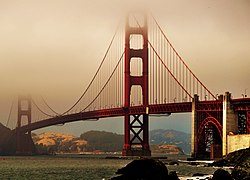
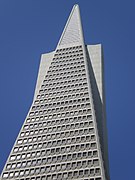
.jpg/271px-Fisherman's_Wharf_(9420511365).jpg)
.jpg/120px-Alcatraz_(14693798129).jpg)



.JPG/270px-The_Castro_with_Castro_Theatre_(TK4).JPG)




.JPG/270px-View_over_San_Francisco_from_Twin_Peaks_(TK20).JPG)




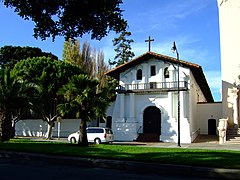








.jpg/240px-Salesforce_Tower_(34578890725).jpg)

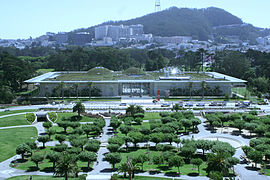










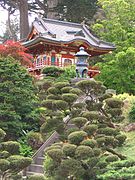






.JPG/220px-Clam_chowder_in_a_Boudin_sourdough_bowl_at_Pier_39_(TK).JPG)